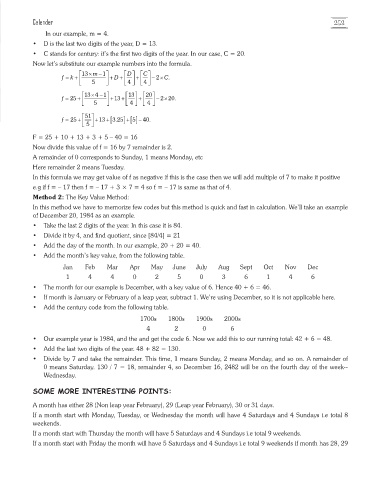Page 257 - Services Selection Board (SSB) Interviews
P. 257
Calender 253
In our example, m = 4.
• D is the last two digits of the year, D = 13.
• C stands for century: it’s the first two digits of the year. In our case, C = 20.
Now let’s substitute our example numbers into the formula.
D
C
13× −m 1
2 C
f = + 5 + D + + −× .
k
4
4
×−
13 4 1 13 20
2 20.
f = 25 + + 13 + + −×
5 4 4
51
= f +25 5 + + 13 [3.25 ] [ ] − 5 40.
+
F = 25 + 10 + 13 + 3 + 5 – 40 = 16
Now divide this value of f = 16 by 7 remainder is 2.
A remainder of 0 corresponds to Sunday, 1 means Monday, etc
Here remainder 2 means Tuesday.
In this formula we may get value of f as negative if this is the case then we will add multiple of 7 to make it positive
e.g if f = – 17 then f = – 17 + 3 × 7 = 4 so f = – 17 is same as that of 4.
Method 2: The Key Value Method:
In this method we have to memorize few codes but this method is quick and fast in calculation. We’ll take an example
of December 20, 1984 as an example.
• Take the last 2 digits of the year. In this case it is 84.
• Divide it by 4, and find quotient, since [84/4] = 21
• Add the day of the month. In our example, 20 + 20 = 40.
• Add the month’s key value, from the following table.
Jan Feb Mar Apr May June July Aug Sept Oct Nov Dec
1 4 4 0 2 5 0 3 6 1 4 6
• The month for our example is December, with a key value of 6. Hence 40 + 6 = 46.
• If month is January or February of a leap year, subtract 1. We’re using December, so it is not applicable here.
• Add the century code from the following table.
1700s 1800s 1900s 2000s
4 2 0 6
• Our example year is 1984, and the and get the code 6. Now we add this to our running total: 42 + 6 = 48.
• Add the last two digits of the year. 48 + 82 = 130.
• Divide by 7 and take the remainder. This time, 1 means Sunday, 2 means Monday, and so on. A remainder of
0 means Saturday. 130 / 7 = 18, remainder 4, so December 16, 2482 will be on the fourth day of the week--
Wednesday.
SOME MORE INTERESTING POINTS:
A month has either 28 (Non leap year February), 29 (Leap year February), 30 or 31 days.
If a month start with Monday, Tuesday, or Wednesday the month will have 4 Saturdays and 4 Sundays i.e total 8
weekends.
If a month start with Thursday the month will have 5 Saturdays and 4 Sundays i.e total 9 weekends.
If a month start with Friday the month will have 5 Saturdays and 4 Sundays i.e total 9 weekends if month has 28, 29

